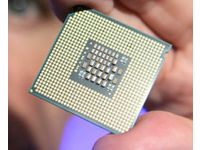Intel to Release Details on 32nm Chip Fabrication Technology at 54th IEDM
If chip fabrication continues on a shrinking trend with Intel expected to release details surround its 32nm chip fabrication technology at the IEEE International Electron Devices Meeting (IEDM) in San Francisco on December 15.
Representatives from Intel will present a paper to discuss how they produced a 291Mb SRAM memory array to test the process – a process which uses high-k and metal gate technologies. Using a 0.171-micron^2 cell size, the device has close to 2 billion transistors and array density of 4.2-Mbit^2 – it operated at 3.8GHz at 1.1 Volts.
Static RAM cells are what chip makers always build first when testing a new fabrication process – and according to Intel, the new process appears to be good. Intel has also claimed that its first 32nm processors, codenamed ‘Westmere’ are expected to debut in late 2009 – essentially be a die-shrink version of their new Nehalem architecture, due out late this quarter.
Intel is also not the only chip maker detailing its progress, however. AMD is claiming the smallest functional SRAM cell ever made at 22nm, high-k and metal gate with a density of 0.10micron^2.
From the sounds of things, we can expect to start seeing 32nm chips from Intel around the third or fourth quarter of 2009 and 22nm chips from AMD. Generally the smaller they get, the lower the voltage – thus lowering the heat. This are going to be pretty cool next year, no pun intended.
Get Tom's Hardware's best news and in-depth reviews, straight to your inbox.
-
jaragon13 Cool stuff. :PReply
You did make a few spelling error here and there,but nothing major.Nice article. -
IBM (not AMD) claimed a functional 22nm SRAM CELL, but no actual details were given. This could mean as little as 6 or 8 working transistors (which comprise an SRAM cell). How you could go from this to expecting a working chip next year is insanity.Reply
You cannot compare a working 2 BILLION transistor SRAM chip and think 6 working transistors means a 22nm IBM (or AMD) chip is coming soon! Are you suggesting they may skip 32nm altogether? Heck even the 45nm are not really out yet - are they just going to run that node for 1 year, skip the next node of 32nm and go to 22nm? You will not see any 22nm chips until at least 2012 (possibly end of 2011 for Intel).
You will also note the IBM cell was a 0.1um density which is not quite 1/2 (which would be expected) of the 0.17um density Intel quoted on the larger technology node. In all likelihood IBM, took some liberties on what "22nm" means - again the lack of details here is quite odd for a company like IBM to leave out... the only detail given was -
jkflipflop98 The author clearly has no clue as to how silicon fabrication works. To suggest that IBM's sram cell will yield a working production chip (for AMD) within a year is simply laughable at best.Reply
Fire this joker and hire some writers that don't put an obvious slant on every article they write. This site will remain a joke until then. -
noobe1981 Then why do you come here? Don't like it leave. Nobody can predict the future. And yes amd's best bet would be to skip a couple steps to jump ahead of intel.Reply -
Best bet? As if they get to just choose that path and take it instead.Reply
People come here because it USED to be a good site, and vendors still give them early press releases. No one can deny the quality has plummeted though. -
zodiacfml nah, you don't know the economy and technical of making chips.Reply
no one can possibly skip a process shrink, its just too difficult and too expensive. its less difficult to go that 32nm process and make money from it first before going directly to 22nm.
don't worry about amd. they don't need to beat intel's best chips but needs too compete closer than we see today. -
jimmysmitty Yea.... 22nm from AMD in 2009..... right.... ok I think he might have thought 32nm? Because the thing is that although IBM announced 22nm SRAM they didn't disclose the info which means they probably don't have it to the point of being able to use yet. And it would take much more than 9-12 months to get it from that state to working.Reply -
da bahstid If you guys would read a bit more closely, the author says 22nm chips from AMD and doesn't specify when. S/he only specifies the date for 32nm from Intel which they have firmly announced. I guess you could argue that the sentence structure is pretty good at drawing a rise out of people though.Reply -
hannibal 22nm would be good, but so far only IMB has talked about it, so it's a long way for AMD to adapt it. All in all the leap directly to 22 for AMD would be nice, but as many has said, difficult to achieve, even the IBM would give all their secrets to AMD... that in itself is guite douptfull.Reply
-
Pei-chen I am sure AMD will release another low voltage 65nm Athlon X2 to counter Westmere seeing how many fan boys think Brisbane beats Wolfdale/Yorkfield.Reply
